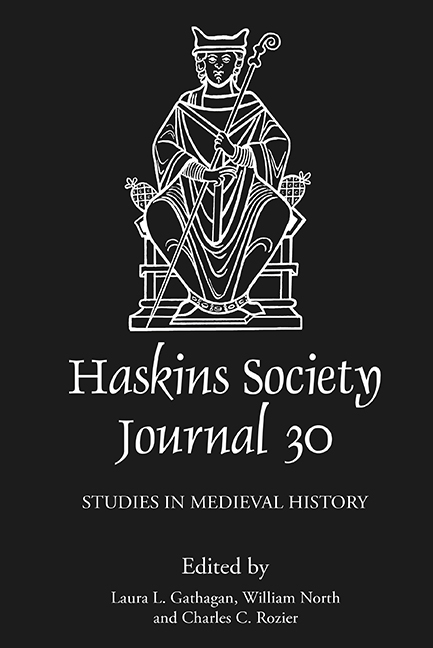Book contents
- Frontmatter
- Contents
- List of Figures and Tables
- Editor's Note
- Abbreviations
- 1 Beyond Corfe: Ælfthryth's Roles as Queen, Villain, and Former Sister-in-law
- 2 Medieval Curses and Their Users
- 3 ‘Although He Was His Nephew’: A Study of Younger Hautevilles Either Side of the Sea
- 4 Nearly Gold and Nearly Perfect? Copper, Meaning, and Materiality in Norman Sicily
- 5 Bound by Loyalty: Conflict, Communication and Group Solidarity in Early Twelfth-Century Southern Italy
- 6 Hugh of Lincoln and Adam of Eynsham: Angevin Kingship Reconsidered
- 7 Earthly Kings, Heavenly Jerusalem: Ralph Niger's Political Exegesis and the Third Crusade
- 8 ‘Holy Christendom's New Colony’: The Extraction of Sacred Matter and the Colonial Status of the Latin Kingdom of Jerusalem
- 9 Medieval French Peasants: The New Frontier?
7 - Earthly Kings, Heavenly Jerusalem: Ralph Niger's Political Exegesis and the Third Crusade
Published online by Cambridge University Press: 30 April 2020
- Frontmatter
- Contents
- List of Figures and Tables
- Editor's Note
- Abbreviations
- 1 Beyond Corfe: Ælfthryth's Roles as Queen, Villain, and Former Sister-in-law
- 2 Medieval Curses and Their Users
- 3 ‘Although He Was His Nephew’: A Study of Younger Hautevilles Either Side of the Sea
- 4 Nearly Gold and Nearly Perfect? Copper, Meaning, and Materiality in Norman Sicily
- 5 Bound by Loyalty: Conflict, Communication and Group Solidarity in Early Twelfth-Century Southern Italy
- 6 Hugh of Lincoln and Adam of Eynsham: Angevin Kingship Reconsidered
- 7 Earthly Kings, Heavenly Jerusalem: Ralph Niger's Political Exegesis and the Third Crusade
- 8 ‘Holy Christendom's New Colony’: The Extraction of Sacred Matter and the Colonial Status of the Latin Kingdom of Jerusalem
- 9 Medieval French Peasants: The New Frontier?
Summary
Like many English clerics, the English cleric Ralph Niger spent the 1160s and 1170s in circles of high ecclesiastical and royal power. While he never ascended to high office himself, he played a minor part in the Becket conflict before serving as a fellow courtier (concurialis) of the historian Gervase of Tilbury at the court of Henry the Young King, son of Henry II. After an otherwise obscure career in which he observed ‘tournaments and various sieges’, he laboured throughout the 1180s to create an impressive body of (still unpublished) biblical commentary that takes up five substantial volumes in the library of Lincoln Cathedral. Always keen to see scripture reverberating in worldly affairs, he sought in his exegesis to discuss those things that ‘seem to me to echo in the things which I heard and saw in the courts of kings and prelates’. He infused his commentaries with references to current trends in legal studies and to recent and ancient historical events, continually trying to trace ‘the forms and changes of regimes from the Nativity of Christ up to the end of time’.
Toward the end of the 1180s Ralph seized an opportunity to bring this political exegesis to bear on a grave crisis. After Saladin's devastating defeat of the Christian forces of the Latin Kingdom of Jerusalem in July of 1187 and the occupation of Jerusalem, the kings of western Europe prepared to undertake what became known as the Third Crusade. Ralph, too, responded, but with pen rather than sword, producing the remarkable treatise De re militari et triplici via Ierosolimitane peregrinationis. Over the course of its four books, he argued that potential military pilgrims ought to build a true Jerusalem in their hearts and at home rather than rush off to the Holy Land. Proceeding through ‘careful investigation of Holy Scripture’ and identifying several possible biblical models for pilgrimage, Ralph found limited scriptural support for crusading. Moreover, he has a particular audience in mind: he aims his advice straight at the heart of Capetian royal power. In his prologue he addressed William of the White Hands, archbishop of Reims, who would oversee the kingdom while the French king Philip II Augustus was in the Holy Land, while the second book of the treatise addressed an inclitus rex, certainly Philip himself.
- Type
- Chapter
- Information
- The Haskins Society Journal 302018. Studies in Medieval History, pp. 159 - 176Publisher: Boydell & BrewerPrint publication year: 2020

